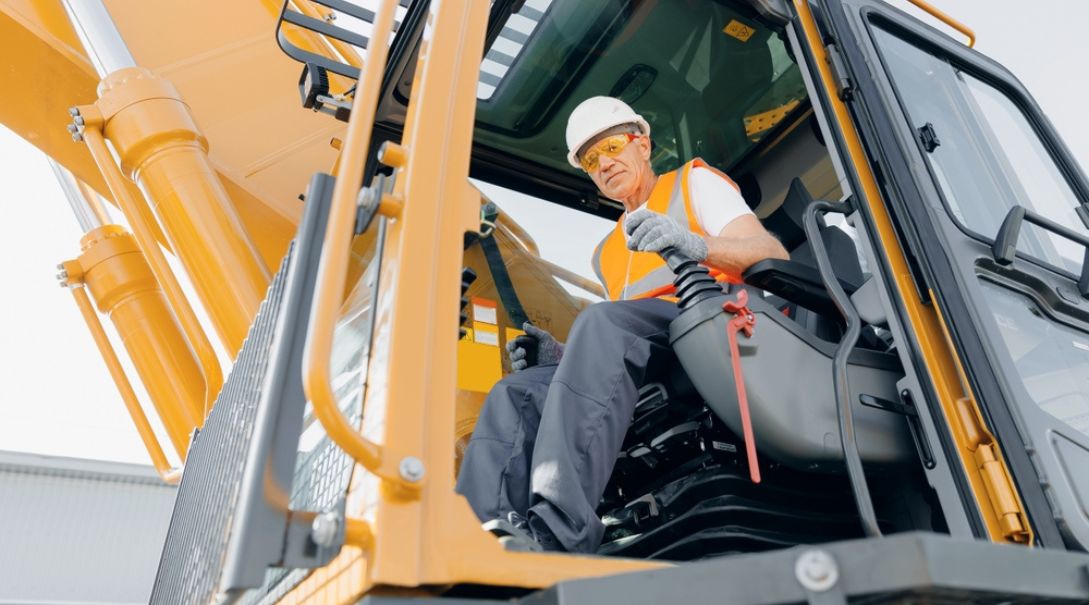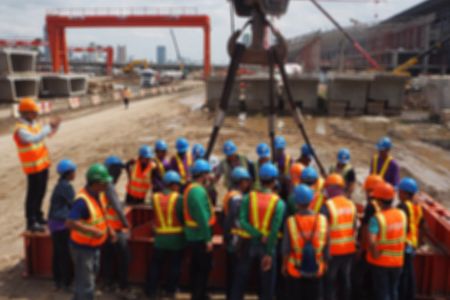A crane represents one of the most powerful (and potentially dangerous) pieces of equipment on a job site. That’s why not just anyone can get behind the controls of a crane. It’s vital to familiarize yourself with safety regulations and certification requirements to minimize the risk of accidents and avoid penalties.
So, who can operate a crane? Here’s everything you need to know about how to become a crane operator.
Table of Contents
Understanding Crane Operator Certifications
You need the right certifications to operate a crane. Having these qualifications ensures that operators are competent, knowledgeable, and equipped to handle the responsibilities that come with crane operation. The certification process includes both practical and written examinations.
Recognized bodies like the National Commission for the Certification of Crane Operators (NCCCO) are responsible for testing applications and issuing crane operator licenses. Each certifying body has specific requirements and standards that must be met before you can sit for an exam.
Crane operator requirements vary depending on what certification you are pursuing (e.g., mobile, tower). Crane operator license requirements also include recertification regulations.
Typically, certifying bodies ask you to demonstrate at least 1,000 hours of crane-related experience during your license period. If you cannot attest that you meet the hourly minimums, you may be required to take both a written and practical exam during the recertification process.
OSHA’s Crane Operator Standards
The Occupational Safety and Health Administration (OSHA) sets strict standards for crane operators in the United States. These rules are in place to ensure that operators have the training and certification needed to handle these large machines safely and effectively.
Under OSHA’s regulations, employers are responsible for ensuring that their crane operators are certified through an accredited program. Your operators must pass written and practical exams to obtain initial licensure and recertify every five years.
If your business owns and operates cranes, you are also responsible for ensuring that they are properly maintained and inspected. Failing to keep your hoisting equipment in good condition can increase the risk of an accident or open your business up to severe liability.
The OSHA website contains a wealth of resources about lifting devices like cranes and derricks. The hoist safety page groups supplemental resources into four main categories:
- Standards
- Construction
- Hazards and Solutions
- Additional Resources
We recommend exploring these resources to learn more about standards and responsibilities relevant to your industry. Failure to comply with OSHA standards could result in fines and other penalties that negatively impact your company’s reputation and productivity.
Types of Cranes and Required Training
There are three main categories of cranes: mobile, tower, and overhead. You’ll need a separate license to operate each kind of machine. However, you aren’t limited to a single license or endorsement. You can obtain licensure for all three categories.
You’ll need to complete both written and practical tests as part of your application process. There are separate exams for each of the three machine classes. Here’s a look at the written and practical examination requirements for each class, as well as how you can recertify:
1. Mobile Cranes and Certification Requirements
Mobile cranes require specialized training and certification. These versatile machines can move freely across various terrains, making them a popular option in a range of industries. However, they also impose additional responsibilities on the operator.
The operator must understand how to manage stability and lifting capacities in variable conditions. With that in mind, the basic mobile crane certification requirements set forth by the NCCCO are as follows:
- Be 18 years of age or older
- Comply with the CCO’s substance abuse policy
- Pass a practical examination
- Pass a written examination
- Comply with the CCO’s Code of Ethics
You must pass the core segment of the written exam and test on one or more specialty designations. You can select a maximum of three specialty examinations. The options include:
- Lattice boom cranes (LAT)
- Telescopic boom cranes — swing cab (TLL)
- Telescopic boom cranes — Fixed cab (TSS)
Your core examination will include 90 multiple-choice questions. You will be given 90 minutes to complete the core exam. The specialty tests include 26 multiple-choice questions. You will have 60 minutes to complete each one.
You’ll also need to schedule and pass a practical exam within 12 months of passing your written test. The practical exam will test your real-world ability to operate one of three crane types: LAT, TLL, or TSS.
You must choose a practical exam that corresponds with the specialty written test that you passed. For instance, if you passed the LAT exam, you must test in a lattice boom crane during your practical exercises.
2. Tower Cranes: Specialized Training and Operation
You’ll need advanced training to operate a tower crane. These huge machines are commonly used in commercial construction projects where you need to lift heavy loads to great heights.
This use case places them in high-risk environments, where factors like wind, limited visibility, and extreme height can make operation dangerous without proper training. You’ll learn many of the basics of safety during your licensure process.
The NCCCO offers a licensure program and maintains the same basic eligibility requirements for the tower crane license. If you meet those standards, you can schedule a written exam comprising 55 multiple-choice questions. You will have 60 minutes to complete the test.
There aren’t any specialty exam add-ons for the tower crane certification. The NCCCO offers a single, all-inclusive test. However, you will have to elect a crane type when taking your practical exam. The three options are hammerhead, luffer, and self-erecting.
You must pass your practical test within 12 months of passing the written exam. The tower crane license is then valid for five years. You must renew it 12 months prior to its expiration date. If you wait until it expires, you will have to complete all new licensure testing requirements.
You’ll have three options for taking your written tests: schedule an event online testing, respond to a local testing facility, or book an online proctored test.
You might want to consider the online proctored option if you have a quiet area free from distractions. It allows you to sit for your crane license from the comfort of your own home, which may help ease test anxiety and eliminate the need to travel.
3. Overhead Cranes and Safe Operation Guidelines
Overhead cranes are widely used in manufacturing plants, warehouses, and industrial settings to move heavy materials across a work area. As an operator, you’ll need to be familiar with the limits of the crane, including movement restrictions and maximum load capacities. You’ll also need to obtain the proper license.
The NCCCO offers an overhead crane licensure program as well. You can book the written exam if you meet the basic eligibility requirements. The single test consists of 65 multiple-choice questions; you will have one hour to complete it. You are allowed to take the practical and written exams in whatever order you choose.
There are two equipment options when scheduling your practical exam. You can showcase your skills in a cab-operated or pendant/remote control crane. As with the other licenses, this certification is valid for five years.
4. Recertification and Continuing Education for Crane Operators
Your crane certification won’t last forever. It will expire every five years, and you must recertify in the 12 months prior to your certification’s expiration date.
You can obtain multiple crane certifications through the NCCCO. For example, suppose that you got your overhead crane license on January 1, 2023. If you then got your mobile crane license on January 1, 2024, both designations would expire on January 1, 2028, five years after your original certification date.
You’ll need to show that you’ve met the 1,000 hours of operational experience requirement for each certification. To understand how this works, consider a scenario in which you are licensed to operate both tower and mobile cranes.
In this case, you’ll need to log 1,000 hours of seat time for each type of machine during your five-year certification period. If you don’t meet the hourly requirements for recertification, you will have to retake the practical portion of the exam.
For instance, if you obtained 1,000 hours of experience in a tower crane, you would be exempt from that practical exam and would only have to take the written test to renew your license. If you fell short of the 1,000-hour requirement for the mobile crane, you would have to take both the written and practical tests.
Remember that even though you may have obtained your certification to operate cranes, you must also ensure you are ready for OSHA inspectors. Failed OSHA inspections can cost you or your company time and money.
Preparing for OSHA Inspections
Ensuring your team is fully prepared for OSHA inspections is crucial to maintaining a safe and compliant work environment. OSHA regularly conducts inspections to verify that operations meet the required safety standards and that employees are properly trained and certified. Non-compliance can lead to significant fines, safety hazards, and potential shutdowns, so being well-prepared is essential.
Alpha-Omega Training and Compliance (AOTC) is here to assist if you’re unsure how to prepare for an OSHA inspection. We provide a wide range of on-site occupational health and safety training tailored to your industry needs. Our expert-led programs help you meet OSHA’s stringent requirements and ensure your team operates at the highest safety standards.
Get ahead of inspections and prioritize your team’s safety. Contact AOTC today to schedule on-site services and ensure compliance with OSHA regulations.


